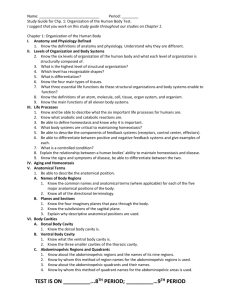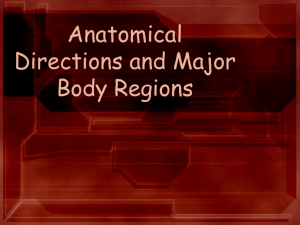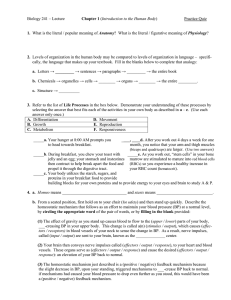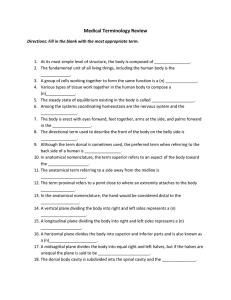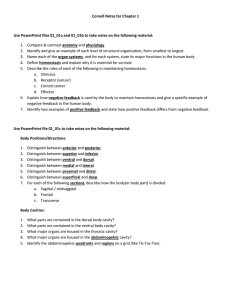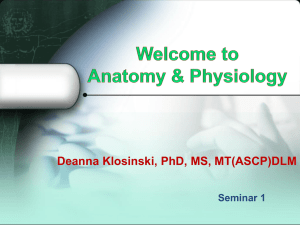1-2
advertisement
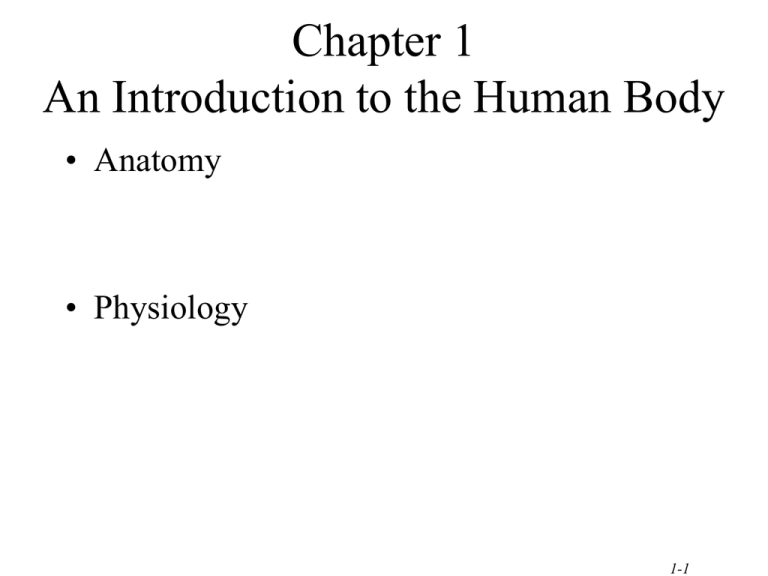
Chapter 1 An Introduction to the Human Body • Anatomy • Physiology 1-1 Levels of Organization • • • • • • Chemical Cellular Tissue Organs System Level Organismic Level 1-2 Levels of Structural Organization • Chemical Level • Cellular level • Tissue level 1-3 Levels of Structural Organization • Organ level • Organ system • Organismic level 1-4 Life Processes • Metabolism = sum of all chemical processes • Responsiveness 1-5 Life Processes • Movement at any structural level • Growth • Differentiation • Reproduction 1-6 Homeostasis • Maintaining the internal environment within physiological limits 1-7 Homeostasis of Body Fluids • Delineation of fluid compartments – intracellular fluid (ICF) = – extracellular fluid (ECF) = 1-8 Control of Homeostasis • Homeostasis is continually being disrupted by – external stimuli or – internal stimuli • Disruptions are usually mild & temporary • If homeostasis is not maintained, death may result 1-9 Neural and Endocrine Controls • Process of maintaining a controlled condition 1-10 Components of Feedback Loop • Receptor • Control center • Effector 1-11 Negative & Positive Feedback Loops • Negative feedback loop • Positive feedback loop 1-12 Homeostasis of Blood Pressure • Pressure receptors in walls of certain arteries detect an increase in BP • Brain receives input and signals heart and blood vessels • Heart rate slows and arterioles dilate • BP returns to normal 1-13 Positive Feedback during Childbirth • Stretch receptors in walls of uterus send signals to the brain • Brain releases hormone into bloodstream • Uterine smooth muscle contracts more forcefully • More stretch, more hormone, more contraction etc. • Cycle ends with birth of the baby & decrease in stretch 1-14 Basic Anatomical Terminology • Anatomical position • Regions of the body • Anatomical planes, sections and directional terms 1-15 Anatomical Position • Standardized position from which to describe directional terms – – – – – – standing upright facing the observer, head level eyes facing forward feet flat on the floor arms at the sides palms turned forward • Prone position = • Supine position = anatomical position? 1-16 Common Regional Names • Clinical terminology based on a Greek or Latin root word. 1-17 Sagittal Plane • Sagittal plane • Midsagittal plane 1-18 Other Planes and Sections • Frontal or coronal plane • Transverse(cross-sectional) or horizontal plane • Oblique plane – 1-19 Planes and Sections of the Brain (3-D anatomical relationships revealed) • Horizontal Plane • Frontal Plane • Midsagittal Plane 1-20 Major Directional Terms • See Definitions page 14 1-21 Superior or Inferior • Superior • Inferior 1-22 Dorsal or Ventral • Dorsal or Posterior • Ventral or Anterior 1-23 Medial or Lateral • Medial • Lateral 1-24 Proximal or Distal • Proximal • Distal 1-25 Dorsal Body Cavity • Near dorsal surface of body • 2 subdivisions – cranial cavity – vertebral or spinal canal • Meninges line dorsal body cavity 1-26 Ventral Body Cavity • Near ventral surface of body • 2 subdivisions – thoracic cavity – abdominopelvic cavity 1-27 Abdominopelvic Cavity • Inferior portion of ventral body cavity below diaphragm • Encircled by abdominal wall, bones & muscles of pelvis 1-28 Thoracic Cavity • Encircled by ribs, sternum, vertebral column and muscle • Divided into 2 pleural cavities by mediastinum • Mediastinum contains all thoracic organs except lungs 1-29 Mediastinum • Midline wall of tissue that contains heart and great vessels, esophagus, trachea and thymus. 1-30 Serous Membranes • Thin slippery membrane lines body cavities not open to the outside – parietal layer – visceral layer • Serous fluid reduces friction 1-31 Pleural & Pericardial Cavities • Visceral pleura Visceral pericardium • Parietal pleura Parietal pericardium 1-32 Peritoneum • Visceral peritoneum • Parietal peritoneum 1-33 Abdominopelvic Regions & Quadrants • Describe locations of organs or source of pain • Tic-tac-toe grid or intersecting lines through navel 1-34 Medical Imaging • Allows visualization of structures without surgery • Useful for confirmation of diagnosis • Examples of imaging techniques 1-35 Conventional Radiography • A single burst of xrays • Produces 2-D image on film • Poor resolution of soft tissues 1-36 Computed Tomography (CT Scan) • Moving x-ray beam • Computer generated image reveals more soft tissue detail – kidney & gallstones • Multiple scans used to build 3D views 1-37 Ultrasound (US) • High-frequency sound waves emitted by hand-held device • Safe, noninvasive & painless • Used for fetal ultrasound and examination of pelvic & abdominal organs, heart and blood flow through blood vessels 1-38 Magnetic Resonance Imaging (MRI) • Body exposed to highenergy magnetic field • Protons align themselves relative to magnetic field • Reveals fine detail within soft tissues 1-39 Positron Emission Tomography(PET) • Substance that emits positively charged particles is injected into body • Collision with negatively charged electrons in tissues releases gamma rays • Camera detects gamma rays & computer generates image displayed on monitor 1-40

